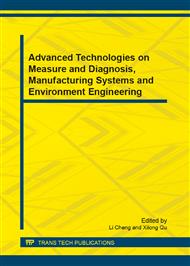p.421
p.429
p.434
p.438
p.443
p.448
p.452
p.457
p.461
Harmonic Vibration Control Synchronization Analysis of Nonlinear System Based on Flux Linkage Estimate
Abstract:
Aimed to the nonlinear harmonic vibration synchronization system which driven by two exciting sources that, the dynamic model of the nonlinear vibration system has been established. According to the electromagnetic driving characteristics of the asynchronous motor that used to be exciting source, and based on the analysis result of the dynamic model, the two exciting sources flux linkage equations and output torque equations have been established in the paper. And the current control regulation model and flux linkage estimate model of the two exciting sources have been derived also. By numerical simulation experiment, the validity of the harmonic vibration control synchronization strategy for the two exciting sources based on the flux linkage estimation has been verified, which can used to provide the basis and protection for the application of the nonlinear harmonic vibration synchronization system that driven by two exciting sources.
Info:
Periodical:
Pages:
443-447
Citation:
Online since:
June 2013
Authors:
Price:
Сopyright:
© 2013 Trans Tech Publications Ltd. All Rights Reserved
Share:
Citation:


